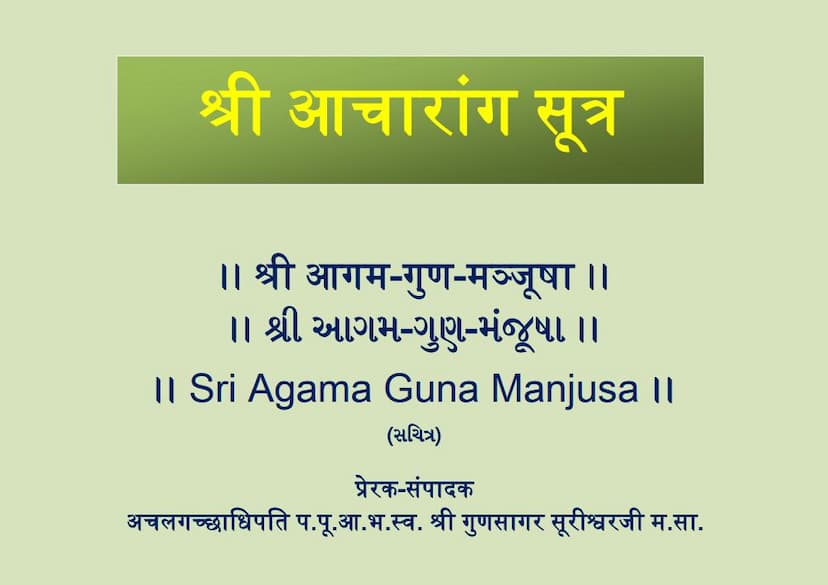Agam 01 Ang 01 Acharanga Sutra Shwetambar Agam Guna Manjusha
Added to library: September 1, 2025

Summary
This document is a comprehensive overview of the "Agam 01 Ang 01 Acharanga Sutra," specifically a Shwetambar Jain Agam text titled "Agam 01 Ang 01 Acharanga Sutra Shwetambar Agam Guna Manjusha," authored by Gunsagarsuri and published by Jina Goyam Guna Sarvoday Trust, Mumbai. The document, presented as a part of the "Jain Education International" initiative for private and personal use, outlines the structure and content of the 45 Jain Agamas, with a particular focus on the Acharanga Sutra.
Key aspects covered:
- Title and Author: Sri Acharanga Sutra, part of Sri Agama Guna Manjusa, compiled/inspired by Achalgachhadhipati Param Pujya Acharya Bhagwan Shri Gunsagar Surishwarji Maharaj.
- Purpose: To provide a concise introduction to the 45 Agamas, serving as a guide for Jain education.
- Structure of Jain Agamas: The document details the classification of Jain scriptures into:
- 11 Angas Sutras: Each Anga is briefly described with its primary subject matter, number of lessons (adhyayan), and approximate verse count.
- Acharanga Sutra: Emphasizes the conduct of monks and householders, primarily focusing on the "Ways of Conduct" (Charanakarana Anu-yoga). It has two parts (Shrut-khanda), 25 lessons, and around 2500 verses. It is considered the first and foundational Anga.
- Other Angas mentioned include Suyagadanga Sutra, Sthana-anga Sutra, Samavaya-anga Sutra, Vyakhya-prajnapti Sutra (Bhagavati Sutra), Jnatadharma-katha-anga Sutra, Upasaka-dasanga Sutra, Antakrida-dasanga Sutra, Anuttarovavaya-dasanga Sutra, Prasna-vyakarana Sutra, and Vipaka Sutra.
- 12 Upangas Sutras: These are described as subsidiary texts to the Angas, covering various aspects like cosmology, life histories, and philosophical discussions.
- 10 Prakirna Sutras: These cover a variety of topics, including religious conduct, astrological summaries, and death rituals.
- 6 Cheda Sutras: These are presented as texts dealing with serious matters of monastic discipline, including rules, exceptions, and criticism. Their study is restricted to highly qualified monks. Examples include Nisi-tha Sutra and Maha-nisi-tha Sutra.
- Two Chulikas: Nandi Sutra and Anuyogadvara Sutra are mentioned. Anuyogadvaya Sutra is highlighted as the "key to all Agamas."
- Four Mula Sutras: Dashavaikalika Sutra, Uttaradhyayana Sutra, and Anuyogadvara Sutra (mentioned again) are listed.
- 11 Angas Sutras: Each Anga is briefly described with its primary subject matter, number of lessons (adhyayan), and approximate verse count.
- Detailed Outline of Acharanga Sutra: The later pages of the document provide a very detailed, chapter-by-chapter (Shrut-khanda, Adhyayan, Uddeshak) breakdown of the Acharanga Sutra's content. This includes:
- First Shrut-khanda:
- First Adhyayan (Shastra Parigna): Discusses knowledge of self and non-self, the existence of life forms (earth-bodied, water-bodied, fire-bodied, air-bodied, plant-bodied, and mobile beings), the concept of karma, and the importance of non-violence (Ahimsa). It details the consequences of harming different life forms and the path to liberation.
- Second Adhyayan (Lokavijaya): Focuses on overcoming worldly attachments, desire, ego, and the pursuit of spiritual liberation. It touches upon impermanence, detachment, and the nature of the world.
- Third Adhyayan (Sheetoshniya): Deals with enduring hardships like heat and cold, the nature of happiness and suffering, and the importance of equanimity.
- Fourth Adhyayan (Dhuta): Explores various ascetic practices, self-discipline, and the path to overcoming vices.
- Fifth Adhyayan (Lokasara/Avanti): Discusses detachment from worldly pleasures, the consequences of attachment, and the path of renunciation.
- Sixth Adhyayan (Mahaparigha): This chapter is noted as unavailable in its complete form but is mentioned in commentaries.
- Seventh Adhyayan (Vimoksha): Deals with liberation, freedom from bondage, and the qualities of liberated souls.
- Second Shrut-khanda: This part is introduced but not extensively detailed in the provided snippets, though it lists several Adhyayans covering topics like Pinde-shana (rules of receiving alms), Parna-shana (rules related to leaves), Vastra-shana (rules related to clothes), Avagraha Pratima (vows related to collecting things), Rata-eshana (rules related to food), etc.
- First Shrut-khanda:
- Hindrances of Lord Mahavira: Pages 14-16 specifically list hindrances Lord Mahavira faced, such as those caused by Sangamadeva, Goshala, a celestial goddess Kataputana, a cowherd, false accusations of theft, and difficulties in non-Aryan lands.
In essence, the document serves as a systematic catalog and introductory explanation of the vast Jain Agam literature, with a deep dive into the ethical and disciplinary teachings of the Acharanga Sutra, emphasizing the conduct of ascetics and lay followers in their spiritual journey.